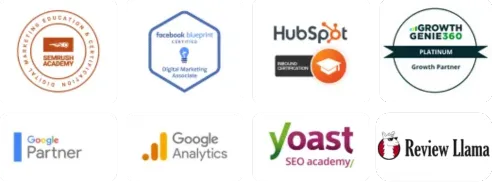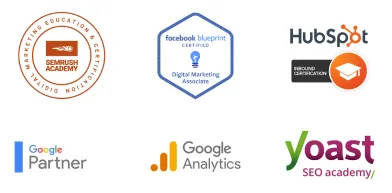TO LEARN IS TO GROW
Learning Center
We do our research and publish our results. Should probably call this the Growing Center.


Top 10 Most Harmful SEO Mistakes & How To Fix Them
Today’s business landscape requires almost all companies, from Fortune Global 500 to home-based companies and solo entrepreneurs, to have a solid strategy in their search engine optimization or SEO.
From a superficial standpoint, SEO may appear like a simple process of improving the quantity and quality of traffic going to your website. But if you look closely, you’d realize that it has more impact on your business, even to the point that it can determine your long-term success and survival amidst this cutthroat market competition.
As a result, some seemingly harmful SEO mistakes might be enough to spell disaster to your business.
Leading digital marketing expert LOJO Marketing explains the top 10 most harmful SEO mistakes and the corresponding ways to fix them.
Low-Quality Content
One of the most common and also the most cringe-worthy SEO mistakes is the use of low-quality content on websites or blogs that can make any reputable company [in the offline world) look sketchy online.
Other companies skimp on hiring high-quality copywriters and resort to article spinners, which are software that “rewords” content to make it appear like a unique article to search engines.
Always bear this in mind: You create content that gives real value to people because traffic comes from them and not from Google and other search engine tools.
How To Fix The Problem:
Hire high-quality content writers.
Slow-Loading Website
While the “acceptable” load time for mobile sites is 1-2 seconds, you should aim for at least a half-second speed. This is especially important for e-commerce sites where online shoppers are less forgiving.
Studies have shown that abandonment rates on e-commerce primarily stem from slow-loading sites.
Snail-paced websites are caused by several factors such as poor hosting services, unoptimized images, too many ads (pop-up adverts), coding errors, use of flash content, and too many HTTP requests.
How To Fix The Problem:
Depending on the root cause of the problem, you can improve your loading speed by upgrading or changing your hosting service, removing pop-up ads and other unnecessary elements, optimizing your images, using caching techniques, and minifying your CSS and Javascript files.
Failure To Utilize Anchor Texts
Anchor texts are the visible and clickable text of a link that plays a critical role in SEO. However, even seasoned digital marketers and SEO writers commit a simple but still damaging mistake–using generic links such as “click here” and “this post.”
Another common mistake is using the same anchor text for every link, which generally looks “artificial” to search engine bots and visitors. Remember, you need to create a user experience that is as “organic” as possible because people want to be informed rather than to be sold to.
How To Fix The Problem:
To make your anchor texts SEO-friendly, write them in a highly descriptive manner. For example, if you’re writing about website designing, use an anchor text that says “website design for local businesses” or something similar.
Another alternative is to turn generic phrases such as “click here” into something more descriptive like “click here to learn more about website designing for local businesses.”
Failure To Mention The Location
If Google bots “think” the location is important in the user’s search intent, they will give more value to the location-based ranking factors. Another thing to keep in mind is that a recent study showed that around 46% of Google searches involved local information, with 72% of people visiting a brick-and-mortar store within 5 miles after doing a local search.

How To Fix The Issue:
First things first, make sure that you mention complete and detailed information about your business–i.e., your address, email, contact number, and operating time–not only on your website (especially the About Us page) but also on social media and other online platforms.
Also, don’t forget to add or claim your business in online directories and listings such as Google My Business, Yelp, Bing, Apple Maps, HubSpot, Yellowbook.com, Super Pages, Thumbtack, Better Business Bureau, MapQuest, and LinkedIn Company Directory.
Ignoring Bad Reviews
Ignoring bad reviews won’t make them go away; doing so can even worsen the problem over time because it gives people the impression that your business does not value their feedback.
How To Fix The Problem:
Before you can manage negative reviews, you need to know where they are coming from. To do this, create Yelp, TripAdvisor, and other accounts from customer review websites and set up notifications.
You can also track social media mentions, which you can do by setting up a social listening stream like Hootsuite and Review Llama.
When dealing with negative reviews, let your own customers speak on your behalf. However, you can point out if they mention any mistake. In addition, you should offer a sincere apology and make a promise to make all your efforts to correct the problem.
While negative reviews might appear like an ego killer, the truth is that they are untapped opportunities, allowing you to improve your products and services, and ultimately, give yourself a competitive edge amidst this fiercely competitive market.
Failure To Optimize The Images
Google bots can “crawl” and “read” texts, but not images, videos, and graphics. Hence, you must always add alternative tags to your images, which are descriptive texts that “tell” a complete message to the search engines.

How To Fix Poorly Optimized Images:
These are the basic guidelines to make your images SEO-friendly:
Use PNG, JPEG, and other web-friendly file formats.
Use descriptive alt text. For example, a photo of a boy swimming in the lake should have an alt text that says, “boy swimming in the lake.”
Use descriptive captions when necessary.
The images should reflect the content or the closest texts.
Add image to your sitemap.
We made a comprehensive blog on how to optimize your image to ensure fast-loading and SEO-friendly websites.
Using “Unreadable” URLs
A URL is a web address that specifies the location of a web page and plays a critical role in search visibility and user experience.
A poorly optimized URL looks like this:
https://lojomarketing.com/learning-center/2021/blogsspec_9811/index.html
By contrast, an SEO-optimized URL looks like this:
https://lojomarketing.com/learning-center/how-a-small-business-can-grow-big-with-local-seo/
You’ll notice that an SEO-optimized URL uses a more descriptive text that people and Google bots can easily understand.
How To Fix The Problem:
These are the guidelines to create URLs that promote better user experience and improved searchability:
URLs should not be longer than 2083 characters.
All characters should be in lowercase.
They should consist of texts that deliver a short but complete message.
Include relevant keywords in your URLs.
Eliminate special characters like !%# (Google bots and people can’t “read” them).
Use HTTPS rather than HTTP to make the page SEO-friendly and secure.
Instead of spaces, use hyphens to separate keywords.
Incorrect Use Of Title Tags And Meta Descriptions
Title tags specify the title of a web page, whereas meta descriptions provide a summary of the web page content.

The title tags and meta descriptions are displayed on the search engine results page or SERP, making them a critical SEO element. As a result, some businesses fall into the trap of over-optimizing their keywords or business name–e.g., using the company or website name for every page of their site.
How To Fix The Problem:
Every page should have unique and descriptive title tags and meta descriptions for a better user experience. Remember, people are the ones who read, share, and bookmark page titles, not search engine tools.
When writing your title tags, a good rule of thumb is to mention the primary keyword, the secondary keyword, and your brand name and ensure that it is not more than 60 characters.
On the other hand, the ideal length for meta descriptions is between 50 and 160 characters. While they have no direct impact on your SEO, they have a significant effect on your click-through rate, and ultimately, your ranking.
When writing your meta description, make sure that you use targeted keywords and convey a clear message to your readers.
Broken Redirects
Broken or faulty redirects generate errors such as 404s that are hard to detect. Over time, they increase your bounce rate and load time, which can ruin your SEO efforts.
How To Fix The Problem:
Eliminate all redirects that have no or little value, generate errors, and point to the wrong place.
These are the other ways to fix the issues:
Redirect 404 pages, also called “Page Not Found” page.
Find and fix all broken redirects, chains, and loops.
Redirect HTTP version to HTTPS.
Run your website through Screaming Frog to fix all the internal links that have 301 redirects from your sitemap.
Not Using Analytics
You cannot measure your success nor make improvements if you are not using analytics to see your website’s actual performance. Also, don’t fall into the trap of thinking that website traffic is the end-all and be-all of SEO.
While a massive amount of traffic gives you a competitive advantage, your ability to convert–for example, turning visitors into actual buyers and prompting users to subscribe to your newsletter–remains the most important SEO goal.
In some cases, it is even better to use highly specific, lower-traffic keywords because they result in lower bounce rates and convert better, especially in terms of sales.
To measure your SEO results or lack thereof, consider using these free tools:
Google Analytics
Google Keyword Planner
Google Trends
Mozcast
Screaming Frog
Link Redirect Trace
SEOlyzer
Keywords Everywhere
These SEO tools can help you with your links, keyword research, on-page SEO, local SEO, mobile SEO, WordPress SEO, site speed, analytics, and rank checking.
Built for Growth. Backed by 25 Years of Trust.
For over two decades, LOJO has been a trusted partner to hundreds of businesses just like yours. Whether working directly with owners, managers, teams, or boards of directors, our goal remains the same: to be a reliable and results-driven asset to your business.
Over the years, we’ve carefully built a team of experts—each selected for their unique skills, strengths, and personalities. Our clients choose LOJO because they know we genuinely care about their success.
And after 25 years of helping businesses grow, we’re more committed than ever.


Built for Growth. Backed by 25 Years of Trust.
For over two decades, LOJO has been a trusted partner to hundreds of businesses just like yours. Whether working directly with owners, managers, teams, or boards of directors, our goal remains the same: to be a reliable and results-driven asset to your business.
Over the years, we’ve carefully built a team of experts—each selected for their unique skills, strengths, and personalities. Our clients choose LOJO because they know we genuinely care about their success.
And after 25 years of helping businesses grow, we’re more committed than ever.




Matthew Rogers, President
iProspect Check
After spending several months reviewing multiple proposals from several different companies we engaged LOJO to develop a new website that represents our company effectively. We worked initially with Stephen Platte who helped create the scope of the project. Stephen was knowledgeable and always followed up with me on time and as promised.
He "closed the deal" for LOJO with his professionalism, service orientation and easy going approach. Once we signed the contract we were introduced to Jay Kelly who would be the creative lead for LOJO. This was the most challenging part of the project for my company, as there was no shortage of ideas from our side. Jay managed the project flawlessly, and once we had all agreed to the design, Jay introduced us to Eric.
Eric Lay is one of the founders of LOJO. Eric took the design we had developed and brought it to life. We delivered content as quickly as he requested it. Eric kept the project on task and we responded by exceeding every deadline for content. In turn, once provided, literally not a day went by that Eric didn't add the content and take the next step. In just a few weeks we launched our new website. Eric is a pleasure to work with.
His positive attitude and consultative approach really enhanced the experience and made a big difference for us in the outcome of our project. We would welcome you to visit our website to take a look at the quality work of LOJO. We are very pleased with LOJO and look forward to working with them in the future as we pursue an aggressive SEO strategy."
After spending several months reviewing multiple proposals from several different companies we engaged LOJO to develop a new website that represents our company effectively. We worked initially with Stephen Platte who helped create the scope of the project. Stephen was knowledgeable and always followed up with me on time and as promised.
He "closed the deal" for LOJO with his professionalism, service orientation and easy going approach. Once we signed the contract we were introduced to Jay Kelly who would be the creative lead for LOJO. This was the most challenging part of the project for my company, as there was no shortage of ideas from our side. Jay managed the project flawlessly, and once we had all agreed to the design, Jay introduced us to Eric.
Eric Lay is one of the founders of LOJO. Eric took the design we had developed and brought it to life. We delivered content as quickly as he requested it. Eric kept the project on task and we responded by exceeding every deadline for content. In turn, once provided, literally not a day went by that Eric didn't add the content and take the next step. In just a few weeks we launched our new website. Eric is a pleasure to work with.
His positive attitude and consultative approach really enhanced the experience and made a big difference for us in the outcome of our project. We would welcome you to visit our website to take a look at the quality work of LOJO. We are very pleased with LOJO and look forward to working with them in the future as we pursue an aggressive SEO strategy."

Matthew Rogers, President
iProspect Check
The team at LOJO were wonderful to work with. They are well organized and very patient as we worked through our marketing strategy and developed a well thought out and clear action plan at a reasonable price. We will definitely be back for our future campaign needs."

Jon Crosby, Founder
Dazil

